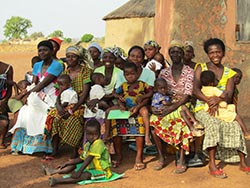Recently, we submitted a paper to the Nutrition Journal on the current and potential role of grain legumes on protein (both quantity and quality) and micronutrient adequacy of the diet of rural Ghanaian infants and young children.
| We collected dietary intake data with repeated quantitative multi-pass 24-hour recall method to assess energy and nutrient (including amino acids) intakes of breastfed children of 6-8 months (n=97), 9-11 months (n=97), 12-23 months (n=114), and non-breastfed children of 12-23 months (n=29) from Karaga district in Northern Ghana. Food-based dietary guidelines that best cover nutrient adequacy within the constraints of local current dietary patterns were designed using the linear modelling programme Optifood. |

|
| Optifood was also used to evaluate whether additional legumes would further improve nutrient adequacy. We found that 40% of the children currently consumed legumes with an average portion size of 20 g per day contributing more than 10% of their total protein, folate, iron and niacin intake. The final best sets of food-based recommendations included legumes and provided adequate protein and essential amino acids but insufficient calcium, iron, niacin and/or zinc among breastfed children and insufficient calcium, vitamin C, vitamin B12 and vitamin A among non-breastfed children. The sets of food-based recommendations combined with extra legumes on top of the current dietary pattern improved adequacy of calcium, iron, niacin and zinc but only reached sufficient amounts for calcium among breastfed children of 6-8 months old. |  |
Thus although legumes are often said to be the ‘meat of the poor’ and the current grain legume consumption among rural children does contribute to their protein intakes, the main nutritional benefit of increased legume consumption is improvement of micronutrient adequacy. Besides food-based recommendations, other interventions are needed such as food-based approaches and/or fortification or supplementation strategies to improve micronutrient adequacy of infants and young children in rural Ghana.
Currently, we are conducting a modelling exercise using the results of the above study as constraints for an optimised diet for an average Ghanaian household throughout the year and investigating what are the ‘food gaps’ in specific seasons and what agricultural interventions would potentially best close these gaps. Preliminary results show that an average farm household in Ghana cannot be self-sufficient in providing all household members with a nutritious diet throughout the year. In the second half of the dry seasons the availability of vegetables and fruits is too low to cover their needs. Improvements in storage methods and/or irrigation options can close these gaps. In case irrigation possibilities are available for an average household, we found that a household need 1.43 ha of land to be self-sufficient and earn an additional farm income that is sufficient to cover food needs that cannot be produced at the farm but are needed for a nutritious diet.
Ahead, I have a lot of final writing to do as I am planning to hand my thesis at the end of October! So hopefully coming soon: a link to my thesis!
Ilse de Jager, Wageningen University & Research, The Netherlands (Click here for her 2017 update)
